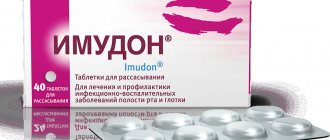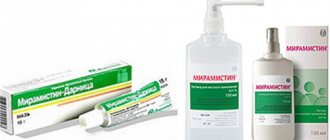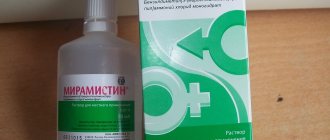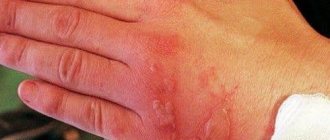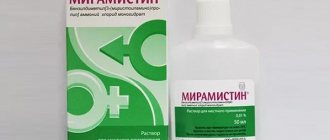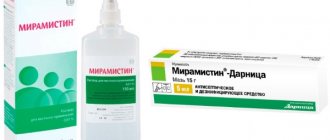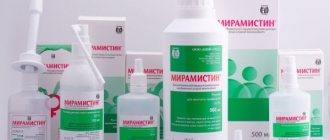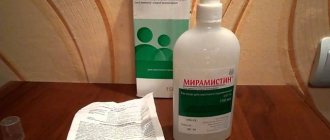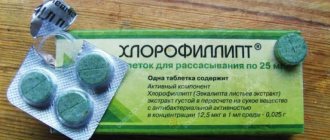Miramistin is a Russian-made antiseptic drug, available in several forms, but for the treatment of ENT diseases, a solution for rinsing or a spray for irrigating the mucous membrane of the throat is more often used.
The advantage of the drug is the possibility of use during pregnancy and pediatrics, the almost complete absence of adverse reactions and effectiveness against a wide range of pathogens.
However, it is important to understand that Miramistin has no analogues in composition, but only in therapeutic effect. The range of such antiseptics is large, so before choosing any of them, you need to consult a doctor and study the instructions for use.
pharmachologic effect
Miramistin is a cationic antiseptic with a wide spectrum of activity. The drug has anti-inflammatory, antimicrobial properties and is used only for external and local use.
It has a detrimental effect on fungi, viruses, and bacteria. After use, the active component of the drug destroys the shell of pathogenic microorganisms, thereby stopping their further reproduction and spread.
The basis of the drug is benzyldimethyl ammonium chloride monohydrate and water. 1 ml of solution contains 100 mcg of miramistin. The medicine has no taste or smell, is not absorbed into the bloodstream, and does not disrupt the functioning of internal organs and systems.
The manufacturer produces its products in several forms; for inflammatory processes of the ENT organs, a solution for gargling in a concentration of 0.01% or a spray for irrigating the throat is used. Cost 100 ml. the drug costs about 220 rubles.
The active component of Miramistin interacts well with the lipid layer of microorganism membranes, which increases permeability and enhances the destruction of diseased microbes.
As a result of this effect, aerobic and anaerobic bacteria, as well as gram-positive and gram-negative organisms, die.
In addition, Miramistin stimulates the functioning of the immune system, accelerates the healing of damaged tissues, and activates various functions of phagocytes.
The instructions for use of the drug indicate that in addition to all this, Miramistin also has an antiviral effect, has pronounced osmotic activity, relieves wound inflammation, and does not cause an allergic reaction. All Miramistin analogues have a narrower spectrum of action, which makes the drug a truly unique product.
Characteristics of Mestamidin
Mestamidine is an antiseptic that can be used by people of any age, even newborns. The medication is prepared in the form of a solution for external use.
The active substances are:
- phenoxyethanol;
- Octenidine dihydrochloride.
Additional substances:
- Coconut oil;
- glycerol;
- sodium gluconate;
- sodium hydroxide solution;
- water.
Additional substances contribute to the activation of the main ones. The medication belongs to the group of antiseptics. The medicine is used only locally. The active ingredients are not absorbed into the bloodstream and do not cause side effects. When treating a wound, the development of a secondary infection is prevented. The medicine is used for diseases of bacterial origin. It is also prescribed as a prophylactic for chronic dermatological pathologies.
Indications for use:
- treatment of wounds, burns, skin inflammations;
- treatment of the surgical site;
- hand treatment of medical personnel;
- mycosis therapy.
The product is used in such branches of medicine as dermatology, proctology, otolaryngology, gynecology. The product is used for antiseptic treatment of skin.
For adult patients, the drug is used to disinfect the skin before surgery or diagnostics, to disinfect the surface of wounds and burns, and to prevent fungal diseases of the feet. Side effects rarely occur when using the product. Since the active substance is safe, it can be used for children:
- for the treatment of sore throat;
- acute form of tonsillitis;
- runny nose;
- to eliminate skin symptoms of chickenpox.
For adult patients, Mestamidine is used to disinfect the skin before surgery or diagnostics.
A contraindication to the use of the drug is hypersensitivity to the components of the drug. During pregnancy and lactation, the product is used with caution. If an antiseptic is used correctly, it cannot cause harm to a pregnant woman, fetus or child.
Mestamidine is used externally. To do this, the affected area is treated in turn with 2 cotton swabs moistened with the product. As an adverse reaction, itching may occur in the area where the solution is used. Some people experience taste changes after rinsing their mouth.
The drug does not interact with other drugs except antibiotics.
The use of Mestamidine reduces bacterial resistance and increases the effects of antibiotics. The activity of the drug increases when it is used in combination with drugs that contain ethanol. In case of accidental ingestion of the drug, it is necessary to rinse the stomach and take sorbents. In case of contact with eyes, rinse them with running water. If an allergic reaction occurs, consult a doctor.
Indications for use
Miramistin solution can be classified as a universal antiseptic. It is used in various areas of medicine when the cause of the disease is pathogenic viruses, fungi or bacteria.
Among the main indications for the use of Miramistin in ENT practice are the following diseases and conditions:
- runny nose of various etiologies;
- tonsillitis – catarrhal, follicular, lacunar in complex treatment;
- adenoiditis;
- otitis;
- bronchitis.
The drug can also be prescribed for other pathologies, including those caused by fungal pathogens.
Moreover, Miramistin is often used for burns, abrasions, inflammation of the genitourinary system, stomatitis, gingivitis and other diseases.
Contraindications and adverse reactions
Miramistin, unlike many analogues, is well tolerated by patients, has virtually no contraindications and extremely rarely causes adverse reactions in the body.
You should stop using an antiseptic only if you are intolerant of the active ingredient.
In rare cases, after using Miramistin, side effects may occur, including:
- slight burning sensation;
- skin rashes.
There were no other symptoms that may indicate drug intolerance in the practice of doctors and patients.
Reviews about the drug are only positive, but in case of hypersensitivity to the active substance, patients are forced to look for a cheaper analogue of Miramistin, which will have the same properties.
Comparative characteristics of miramistin and chlorhexidine
Miramistin or chlorhexidine, what are their similarities and differences?
If we consider the scope of application, then there are no practically significant differences, because the list of medical areas is the same. Due to the fact that the structure of the drugs is different, you can notice a slight discrepancy in the purpose (indications).
The activity of chlorhexidine is slightly lower; unlike Miramistin, it is not sensitive to Koch's bacillus (tubin infection), Pseudomonas aeruginosa, and some Proteas. These pathogenic microorganisms require only potent antibacterial agents.
Miramistin can suppress them, but, as practice shows, it is better to fight dangerous infections in a comprehensive manner. For example, for tuberculosis, up to 4–5 antibacterial agents are used simultaneously, and for a long period.
Chlorhexidine is not able to destroy bacterial spores. According to statistics, chlorhexidine is no longer used for treatment, but as a disinfectant in medicine. It should be noted that chlorhexidine is a fairly popular drug in veterinary medicine.
Chlorhexidine is not used in ophthalmology, because there is a danger of developing a burn of the conjunctiva. You cannot use iodine and chlorhexidine at the same time. The restriction for prescribing the drug is children under 12 years of age.
According to research, it has been determined that Miramistin has a great effect against pathogenic microflora. It covers a huge spectrum of bacteria, so it is effective against various infections. This includes streptoderma, trophic ulcers, candidiasis, chlamydia and others.
Miramistin acts gently and does not cause burns, so it is often prescribed for gargling. If for some reason Miramistin is not suitable, it can also be replaced with chlorhexidine. The peculiarity of Miramistin is its ability to destroy dangerous strains of bacteria that are resistant to antibiotics.
There is information that miramistin reduces the effect of antibiotics, and their combined use remains a controversial issue. Miramistin is also more active against viruses and fungi, especially in immunodeficiency states. Mycoses of various etiologies respond better to Miramistin.
The hypoallergenic nature of Miramistin expands the range of patients; it is prescribed to children, pregnant and lactating women and allergy sufferers.
List of cheaper analogues of Miramistin
Miramistin cannot be classified as an expensive drug, since its price does not exceed 250 rubles per bottle, however, there are cheaper antiseptics that are successfully used in the treatment of ENT pathologies.
The most inexpensive drugs are those from domestic manufacturers:
- Chlorhexidine is an analogue cheaper than Miramistin, which is highly effective in the treatment of diseases caused by Escherichia coli, staphylococci, streptococci and other bacteria. Available in solution for rinsing or inhalation, intended for external or local use only. The cost does not exceed 20 rubles per 100 ml bottle.
- Rotokan is an inexpensive drug based on herbal ingredients. The composition contains chamomile, calendula and other herbs. Intended for inhalation or rinsing. The cost of the solution per 100 ml does not exceed 60 rubles.
- Chlorophyllipt is an antiseptic of plant origin. Available in several forms - tablets, alcohol rinse or oil solution. The price of the medicine is about 100 - 140 rubles.
- Furacilin is an effective and inexpensive antimicrobial drug with broad antibacterial activity. Available in tablets, from which you can prepare a solution for gargling the mucous membrane of the throat. Also provided in the form of a ready-made solution - 0.02% 200 ml. The average price for medicine is from 20 to 70 rubles.
List of similar substitutes for children
For children, the list of drugs that can replace Miramistin is even longer, but before using any drug you need to consult a doctor.
The following medications can be used in pediatrics:
- Hexasprey is a strong antiseptic in aerosol form. The basis of the medication is biclotymol, which copes well with sore throats and speeds up recovery. Can be used from 6 years of age. Cost from 227 rub. for 30 ml.
- Cametone is a combination preparation based on eucalyptus oil, menthol, chlorobutanol and camphor. It destroys pathogenic bacteria well, eliminates sore throat, and relieves inflammation. The price of antiseptic is about 120 rubles.
- Tantum Verde is a good analogue of Miramistin for children; it is an anti-inflammatory drug to relieve sore throat. The drug is in demand in dentistry, otolaryngology and is available in several forms; the cost of a solution for gargling starts from 320 rubles. per bottle 120 ml. Children are prescribed a spray from the age of 3, which costs from 300 rubles. for 30 ml.
- Orasept spray would be a good replacement for Miramistin, but the price of the medicine is higher, about 300 rubles.
- Yox is an antiseptic based on povidone-iodine and allantoin. Used for rinsing or treating the throat mucosa, effectively relieves inflammation, eliminates pain, and can be prescribed to children from 8 years of age. The price does not exceed 100 rubles.
- Lugol is a cheap iodine-based spray for irrigating the throat or a solution for treating the mucous membrane of the oropharynx. The drug in the form of a spray can be prescribed to children from 6 years old, and a solution for treating the throat from 1 year. The cost of the medicine is from 115 rubles per 50 ml bottle.
- Protargol is a silver proteinate with pronounced antimicrobial and antifungal activity. It is used to treat inflammation of the nasopharynx, throat, and also for otitis media. Allowed for children from 6 months. Price – 90 rubles.
Patient reviews
Evgeniy N.: “I suffer from chronic tonsillitis, periodically it worsens - swelling, pustules and plaque appear on the tonsils. In addition to antibiotics, I also use antiseptics. I tried many drugs in search of an effective antiseptic and I think Hexoral is the most effective. It relieves inflammation, stops the development of infection and anesthetizes the throat cavity, which significantly improves the general condition. I believe that the product is completely worth its price.”
Alexander Sh.: “Miramistin is a good drug. We use it often and don’t buy cheap substitutes. The child ate ice cream in large chunks - the throat was immediately treated and illness was prevented. I got caught in a downpour, my temperature rose in the evening, it became unbearably painful to swallow - I took Miramistin before bed, in the morning the pain became weaker, and by the evening of the next day it was completely gone.”
Miramistin or Chlorhexidine - which is better?
Chlorhexidine is an analogue of Miramistin, only 8 times cheaper, which has a different composition but the same therapeutic effect.
Doctors believe that both drugs have an identical effect in the fight against pathogenic microorganisms, and the only difference between them is the composition and price.
Judging by the reviews, Chlorhexidine is effective for bacterial throat diseases. It has pronounced antiseptic and antimicrobial properties, and also copes well with fungi and viruses.
The active component of the drug is chlorhexidine bigluconate, which suppresses strains of many dangerous bacteria.
The medicine is available in different concentrations, but in the treatment of ENT diseases, a 0.05 to 0.2% solution is used.
Reviews from doctors about Hexoral and Miramistin
Daria, 38 years old, Moscow, pediatrician: “Hexoral quickly eliminates sore throat caused by fungal and bacterial infections. The therapeutic effect begins on the third day of treatment. The drug has the disadvantage of a pronounced mint taste, which the child may not like. Miramistin does not contain aromatic additives, which makes it possible to use the drug for the treatment of children of any age.”
Irina, 43 years old, Kaluga, therapist: “Miramistin is an affordable and effective remedy that can be used in the treatment of infections of the upper respiratory tract, genitourinary system, skin and soft tissues. The drug is able to suppress the proliferation of viruses and intracellular parasites. Hexoral is used only in dentistry and otolaryngology.”
Previous article: Comparison of Lisinopril and Enalapril Next article: What is the difference between Troxevasin and Troxevasin Neo?
Tantum verde or Miramistin
Complex treatment of otolaryngological diseases often includes the use of a spray or solution for rinsing Tandum Verde, which has anti-inflammatory, antiseptic properties and is often used in the treatment of sore throat, tonsillitis, and laryngitis. The drug contains glycerol and benzydamine.
The active components effectively cope with pathogenic microorganisms, block their growth and reproduction. Tandum Verde can be prescribed to children from 3 years of age.
If we compare the drug with Miramistin, we can note their different composition, but a similar therapeutic effect from use.
Like Miramistin, Tandum Verde can be used during pregnancy and lactation.
The significant difference between the two drugs is their price - Tandum Verde costs a little more, about 300 rubles per bottle.
Hexoral or Miramistin
One of the best analogues of Miramistin is Hexoral, which is provided in the form of a spray and has persistent and broad antiseptic properties.
The drugs have a similar effect: they destroy bacteria, fungi and viruses, interact well with other drugs and are prescribed for the treatment of sore throat, acute respiratory infections, and acute respiratory viral infections.
However, Miramistin has a wider spectrum of action - it increases local immunity and promotes the regeneration of damaged tissues of the throat mucosa.
Hexoral does not have such properties and its cost is higher than the domestic Miramistin.
Octenisept or Miramistin
Octenisept spray is also an antiseptic; the medicine contains phenoxyethanol and okenidine hydrochloride.
The active ingredients can cause irritation of the mucous membranes and an unpleasant bitter taste in the mouth; they are prescribed to children over 14 years of age. Miramistin is a tasteless, odorless liquid.
The antiseptic Octenisept has only one contraindication - hypersensitivity to the active substance.
Based on this, we can conclude that Miramistin will be better when it comes to treating children. The price of Octenisept is about 500 rubles. for 1 bottle of 50 ml.
What is better - Furacilin or Miramistin?
Furacilin is a cheap analogue of Miramistin, has a similar antiseptic and antibacterial effect, and is used to disinfect affected areas of the skin and mucous membranes.
It is used to treat sore throat, stomatitis, and gingivitis.
Gargling with Furacilin will help have a detrimental effect on pathogenic bacteria, suppressing their growth and reproduction.
Miramistin not only demonstrates an antiseptic effect, but also stimulates the body's defenses and promotes the healing of mucous membranes.
Experts say that for external use (wounds, burns) it is better to use Furacilin, and for throat diseases - Miramistin.
Preparations based on essential oils
These include Chlorophyllipt and Inhalipt.
Chlorophyllipt is a drug used for such indications as sepsis, purulent-inflammatory processes in the cavities and spaces of the chest and abdominal cavity, ulcers, carriage of staphylococcus, and so on. It is not used in gynecology (with the exception of cervical erosion), venereology, and dermatology.
The drug acts primarily on pathogenic staphylococci. Contraindications include intolerance to eucalyptus extract, and side effects include allergies.
It can be used in relation to pregnant and nursing mothers, and is also a good analogue of the drug for children from 2 years of age as prescribed by a doctor.
A drug of this composition is a golden classic in therapy with natural drugs, which is why many people like it more than Miramistin, demonstrating high efficiency at a low cost.
Miramistin is a rather expensive medicine, and citizens often puzzle pharmacists with a request to provide more affordable substitutes.
A review of effective generics Miramistin will help you choose the right replacement option.
Attention! Before purchasing and using generic drugs, consult with your doctor about the advisability of changing the medication.
Antiseptics for children
Children's substitutes:
- Octenisept.
- Malavit.
- Chlorophyllipt.
Octenisept is used for gargling, diluting the medicine with water in a ratio of 1:6.
Malavit, consisting of natural ingredients, is classified as a health product and is used for external and internal use. The drug has a pronounced antiseptic and analgesic effect, and is also used in the prevention and treatment of acute respiratory infections.
In addition to these products, cheap children's analogues of Miramistin include: Ingalipt (price 30 ml - from 87 rubles), Lugol spray (50 ml solution will cost a little more than 100 rubles). It is also worth paying attention to Hexoral (about 280 rubles for 200 ml).
Generic spray for children
Of the foreign substitutes for Miramistin spray, it is worth paying attention to:
- Italian remedy Tantum Verde;
- Ukrainian analogue of Miramistin - Dekasan.
Antiseptic Tantum Verde is effective in the treatment of dental and ENT diseases. The drug is produced in the form of a spray, rinse, lozenges, for children and adults.
Decasan spray is an antiseptic that kills harmful microorganisms and is considered a worthy substitute for Miramistin.
The product has a local effect and does not affect healthy areas of the skin and mucous membrane.
Decasan is used in the treatment of:
- fungal and bacterial etiologies;
- gynecological pathologies;
- dental diseases.
The drug is effective in the treatment of inflamed tonsils in children.
Decasan is not used in the treatment of burns, ear inflammation (instillation), but is used for inhalation and the treatment of bronchitis.
Attention! Decasan causes allergic symptoms, including in children.
Miramistin or Lugol
Comparing Miramistin and Lugol, you can find a number of differences - both drugs have different composition, cost and mechanism of action.
Lugol has an anti-inflammatory and antimicrobial effect, is used in the treatment of ENT diseases, and can be prescribed to children older than 6 months.
The main active ingredient of the analogue is potassium iodide dissolved in glycerin.
The drug is a natural antiseptic and has a detrimental effect on viruses, fungi and bacteria. However, it has a number of contraindications that you need to familiarize yourself with before use.
Miramistin, in comparison with Lugol, has a wider spectrum of action and also has better tolerability, which is important in the treatment of people with diseases of the endocrine system or intolerance to iodine.
Comparison of Hexoral and Miramistin
Analysis of the properties of drugs helps to detect both common and distinctive features.
Similarities
General characteristics of the drugs include:
- pharmacological group (both Hexoral and Miramistin are local antiseptics);
- the possibility of use for the treatment of inflammatory processes in the throat and oral cavity;
- pharmacokinetics (both drugs act within the skin and mucous membranes).
What is the difference?
The differences between Hexoral and Miramistin are the following characteristics:
- release form (the first drug is offered in the form of a solution and an aerosol, its analogue is available only in the form of a solution);
- type of active substance;
- indications for use (Miramistin has a wider list of indications, Hexoral is used only in the treatment of diseases of the mouth and throat);
- side effects (Hexoral often causes allergic reactions, Miramistin is better tolerated by patients);
- restrictions on use (Miramistin can be used to treat infectious diseases in children, Hexoral is prescribed to patients over 3 years of age).
Which is cheaper?
Hexoral has a lower price than Miramistin.
Chlorophyllipt or Miramistin
Antiseptics of plant origin include Chlorophyllipt, which has antimicrobial activity and is especially effective against staphylococci.
The antiseptic has a natural composition - extract of eucalyptus globulus leaves dissolved in oil in a 2% concentration.
Both drugs are used in the treatment of diseases of the throat and nose, bacterial etiology and can replace each other. The analogue can be used from the age of 3, but only when the patient is not allergic to eucalyptus.
It penetrates well into the mucous membranes, cleanses lacunae from purulent plugs and plaque during sore throat, and also copes well with bad breath. The proportions of the solution for gargling with Chlorophyllipt are described in this article.
Which of the two drugs is better is up to the attending physician to decide, especially when it comes to a child.
Choosing the right drug
A comparison of drugs shows that they differ from each other in various characteristics. But one of the same points is that their scope of application is almost the same. There are certain points in which Miramistin can easily replace Chlorhexidine . This includes the prevention and treatment of sexually transmitted diseases, burns and wounds, inflammatory diseases of the throat and mouth when there is a certain concentration of the composition.
And only when treating the throat should preference be given to Miramistin. This is the best spray for the treatment of all diseases in otolaryngology.
